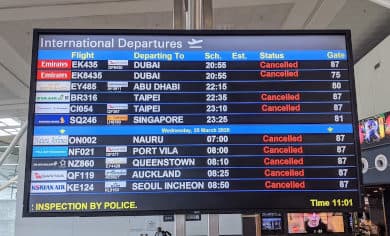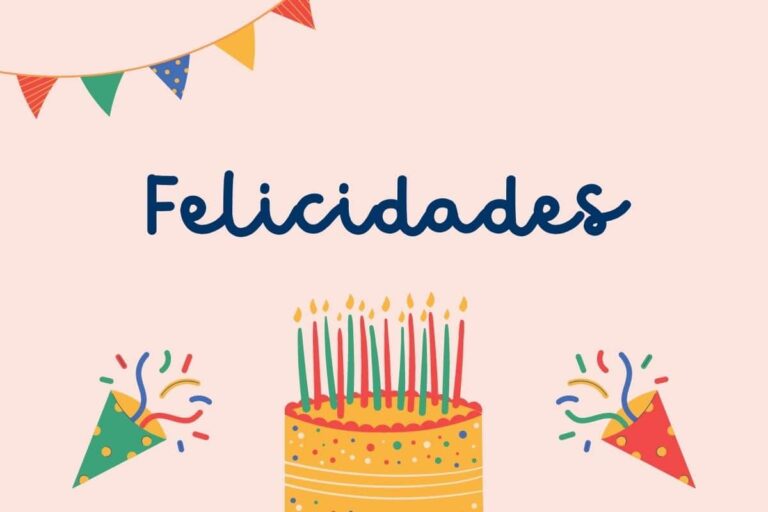Colombia’s Menú del Día in Spanish — A Complete Guide
The menú del día is one of the staples of the Colombian eating lifestyle. It’s also one of the most cost-effective and balanced meals I’ve encountered anywhere in the world.
So this is our guide to ordering the Colombian menú del día (aka menú ejecutivo), the pinnacle of cheap food in Colombia, in Spanish.
Ordering the menú is also a great way to feel “local” every day. Most places where we ate in Cali and Medellín had NO other foreigners in them, and we even sometimes chatted to the others at the tables around us when the mood was right.
But ordering the menú is hard. For one thing — there’s usually no written menu. You have to discuss the whole thing in Spanish. What does it come with? What soups? What mains? What side dishes? What drinks? And you have to know what all those names mean or you’ll be totally lost!
That’s why we created this guide to ordering the menú del día in Spanish. We were lost, and then we found ourselves, and now we want to help you feel like a local in Colombia as well.
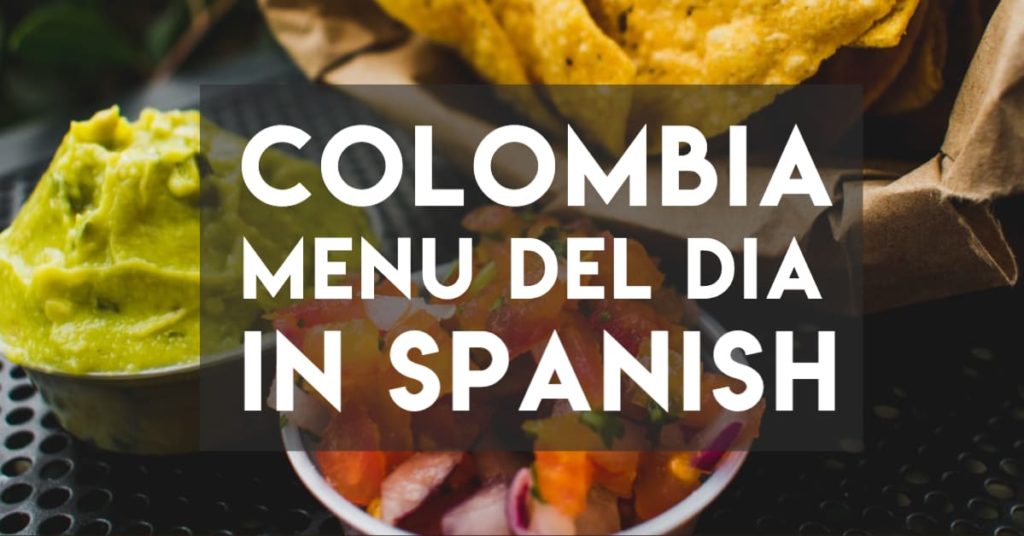
Quick background on us: We’re fluent in Spanish (it’s a vague definition, but essentially I have worked in Spanish and mostly am working on improving local Colombian slang), but we’re not native. So we learned the below ourselves by living in Colombia and figuring it out. Consider this a guide from fellow Spanish learners a few steps ahead.
See our more complete guide to living in Colombia for more general tips on the country.
And if you’re interested in finding the best menú del día options in Medellín (particularly around the popular Poblado area), check out the post by our friends Chris and Kim on their blog The Unconventional Route.
Become a Discoverer. Get the PDF Guide.
Like this guide? Subscribe to our email list below and we’ll send it to you in PDF form without any ads. You’ll also join our email list of weekly insights into languages, culture, and distant places.
Contents
Overview of ordering the Menú del Día in Spanish

The menú del día, or “menu of the day”, is the basic worker’s lunch in Colombia. It’s cheap, pretty healthy, good quality, tasty enough, and very, very good value — especially if you’re thinking in foreign currency (which, of course, the locals are not).
When the menú del día is served: Typically — in fact, everywhere we’ve been — you can only order the menú del día from 12pm (noon).
If you come earlier than noon, many places will offer you a breakfast (desayuno) option, which is a highly regional one.
The price of a menú del día is very low. It is so cheap that it can range from as little as 5,000 COP — less than US$2 — for a full meal including a soup, a big plate of food, and a drink!
Pay a little more — 10-10,000 COP ($3-5), and you can get a pretty tasty and generously-sized meal.
Sizes of the menú: The menú del día comes in two main sizes: sencillo (simple) for just the meal, and ejecutivo (executive), which is the complete three, and reserved only for people who wear a suit and tie, drive a BMW and wear a Bluetooth earpiece. (J/k, do not ever wear a Bluetooth earpiece.)
If you get the sencillo, you’ll just get the main plate (and maybe a drink), and typically pay about 1-2,000 COP less.
If you get the ejecutivo, you’ll get a soup and a drink in your still very-economical meal deal.
Either way, you get a choice of foods and condiments. The best way to eat cheap food in Colombia, in my experience, is to eat where the locals eat.
This means it’s a spoken menu, and you have to order in Spanish in most places.
So that’s why, after eating dozens of these meals, I’m putting together this guide to ordering the menú del día in Spanish. Ordering food in Spanish can be intimidating, but there’s no reason!
Phrases for ordering the Menú del Día in Spanish

When walking up to a place and checking it out, you have to make some enquiries about what there is to eat.
While there are some standard options seen almost everywhere, most restaurants change their menu daily. The soups, mains, and drinks all can vary, even at the same place (even at different times of the afternoon).
Here are some phrases to get started ordering the menú del día in Spanish.
| English | Spanish |
|---|---|
| Hi, what is there to eat? | Hola, buenas, ¿qué hay para comer? |
| Is there something left to eat? (if you’re showing up a bit after lunch hours) | ¿Queda algo para comer? |
| How much is the menu of the day? | ¿Cuánto vale el menú del día? |
| Is there something without meat/a vegetarian option? | ¿Hay algo sin carne/una opción vegetariana? |
| What would you recommend? | ¿Qué recomendarías? |
| What do most people order? | ¿Qué es lo que la mayoria ordena? |
| Is there a special of the day? | ¿Hay algún especial del día? |
| Does it include soup/drink? | ¿Lleva sopita/bebida? |
Once you’ve asked what there is to eat, you might find that they start with soups, then main dishes, and finally drinks.
Soup (Sopa/sopita, Caldo/caldito)
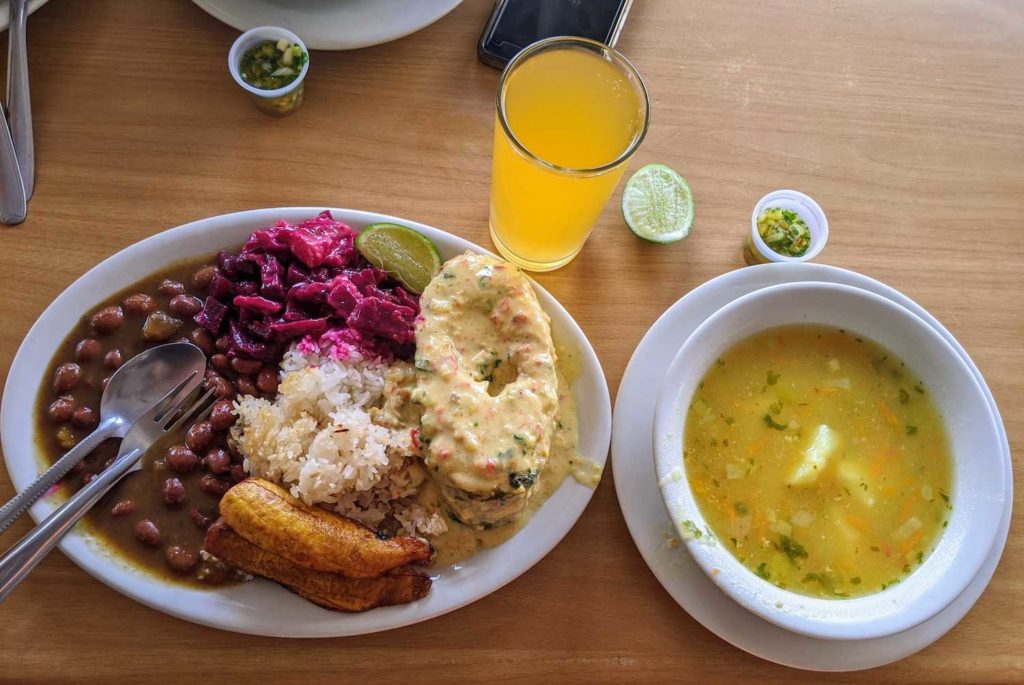
“Para sopita tenemos…”
Colombian restaurants will usually offer a choice of soups (often called the sopita — Colombians love to use the diminutive form!), can range from thin to hearty.
These will include (this time I’m starting with Spanish, as you’re listening to the options!)
| Spanish | English |
|---|---|
| Fríjoles | Beans. Note that Colombians emphasise the first syllable. This was my favourite high fiber/protein and filling option. |
| Verduritas | Vegetables, often including potatoes |
| Crema de choclo | Cream of corn soup. Choclo is a maize-like corn, kind of in between. No, it’s not chocolate, keep your pants on. |
| Pasta | A noodle/pasta soup (heavy, too) |
| Caldo (caldito) de pescado/res | Basically broth from a larger soup. You might get a couple of morsels of meat, but not much. Thin. May include potato. |
| Sancocho de pescado/res | The flavoured broth from a larger sancocho stew. Think of this as a variant on the caldo soup. Sancocho can also be ordered as a main (and you get much more than the broth) |
| Papas criollas | A soup in meat broth but with small potatos in it. Delicious! |
| Ajiaco | A typical light Colombian broth of corn, potatoes, and chicken. Also can be ordered as a main. Highly recommended as either soup or main! |
| Guineo | Soup made from small, sweeter, and less starchy plantain bananas. |
Then they’ll offer condiments, including cilantro (Spanish for cilantro; curb your shock), and aji.
Probably the most common condiment is aji. This is a mixture of pickled chillies, maybe in chopped form, maybe just in slice. It looks a lot hotter than it is — I’d think of it mostly as spicy pickles.
Taste a little aji before piling it on. The spiciness level varies.
Main meal (Para comer)
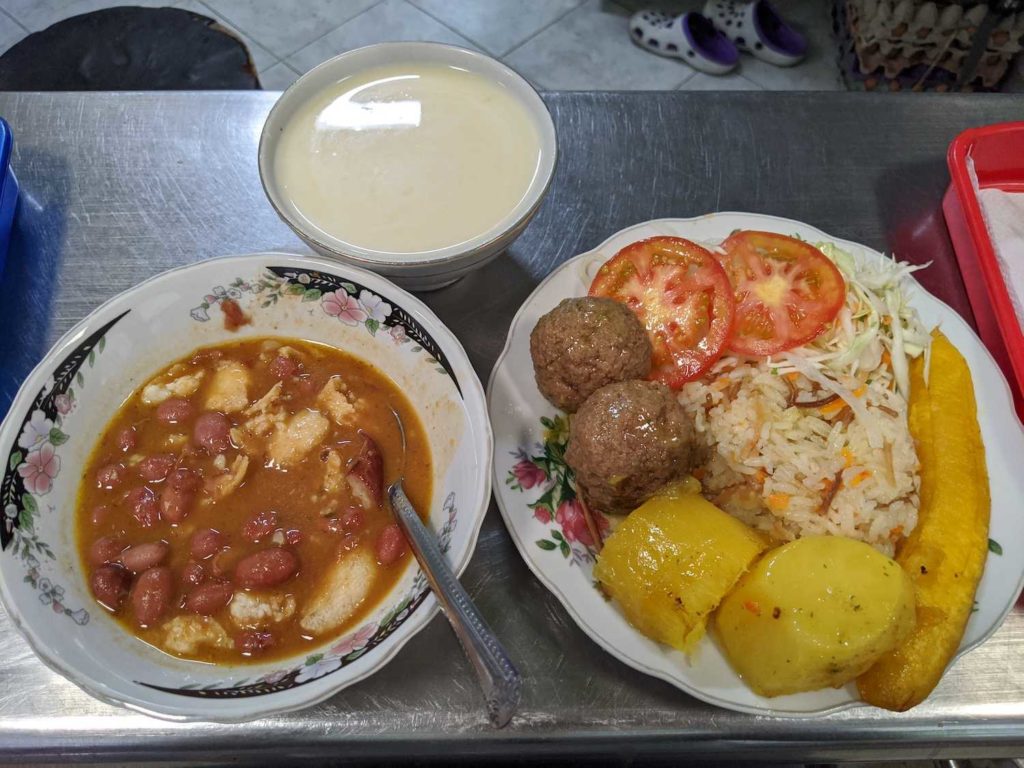
In general, you can get a range of meats, including res (beef) and cerdo (pork). either in deep-fried, pan-fried, or boiled/stewed form.
You can also get a couple of other things, including stews, tamales, and other specials of a local restaurant. That’s why you have to ask.
Here’s what we’ve come across most often, though there are many regional variations.
| Spanish | English |
|---|---|
| Pescadito (frito) | A fried fish, or fillet of fish. Tender, juicy, and great value. This was common for us in Cali and in the coastal areas — we saw it less often in Medellín. Sometimes a specific fish, like trucha in the zona cafetera region (which they offer in either a la parilla — grilled, frita — fried, or al vapor — steamed). |
| Pollo Asado | Fried or grilled chicken — usually dark meat (a thigh + leg). This is always delicious and economical! |
| Carne sudada | Boiled/stewed meat. You usually get a choice of meats, at least including res (beef), and cerdo (pork), or a cut of meat like sobre barriga (sirloin) for a bit more. Generally a fairly “safe” but uninspiring option. Served with rice and other carbs + salad. |
| Carne Molida | Minced meat. Basically… hamburger, or sloppy joe type meat. Unexciting, but inoffensive. |
| Albóndigas | Meatballs served in a thin broth. Good over soup! I always like meatballs because they’re the kind of thing I can’t ever be bothered making myself. |
| Chuleta de cerdo, pescado | A more expensive grilled food option, because a chuleta is a cut of meat. You may pay 15,000-20,000 COP for this meal deal. |
| Higado encebollado | Liver fried in onion. May be my middle eastern roots (still one of my favourite Egyptian foods), but just thinking about this gets me salivating. |
| Carne asada | Grilled (pan-fried) meat, literally “sweated” meat. You usually get the option of res or cerdo. This meat is (in our experience) always well-done and a bit tough. Same as above, you get a choice of meats, at least including res (beef), and cerdo (pork). |
| Pechuga (de pollo) | A grilled chicken breast. If they don’t say it’s de pollo, you can assume it! I usually didn’t like this because it was always dry/tough. |
| Calentado | Literally “heated up”, this is a refried mix of yesterday’s rice and beans. Typically a breakfast, but you can also order it for lunch sometimes. It’s hearty and delicious. |
| Bandeja Paisa | A classic but somewhat overrated (yes, you heard me) “big breakfast”. The bandeja paisa is the “big breakfast” of Colombia. It just means rice, avocado, an egg, sausage, chicharrones, a patacón, and maybe another couple of carbs. I had it at two places and both times I thought “is this what everyone was raving about?” |
| Lengua | Tongue stew, as you maybe can imagine! It nearly always means cow tongue, stewed. It’s quite tender. Try it once! |
| Mondongo | Very typical, very country, very cow stomach soup. Everyone will try to sell it to you, but only eat this if you know you’re eating a hearty tripe soup. It can be tasty, if but make sure it’s in a place where it’s hot and cooked fresh (i.e. there are people there, and it’s not 4pm). |
I’m sure there are other typical menú options, especially in different cities around the country.
If there’s one favourite you have to mention, please tell us (especially while we’re still in Colombia).
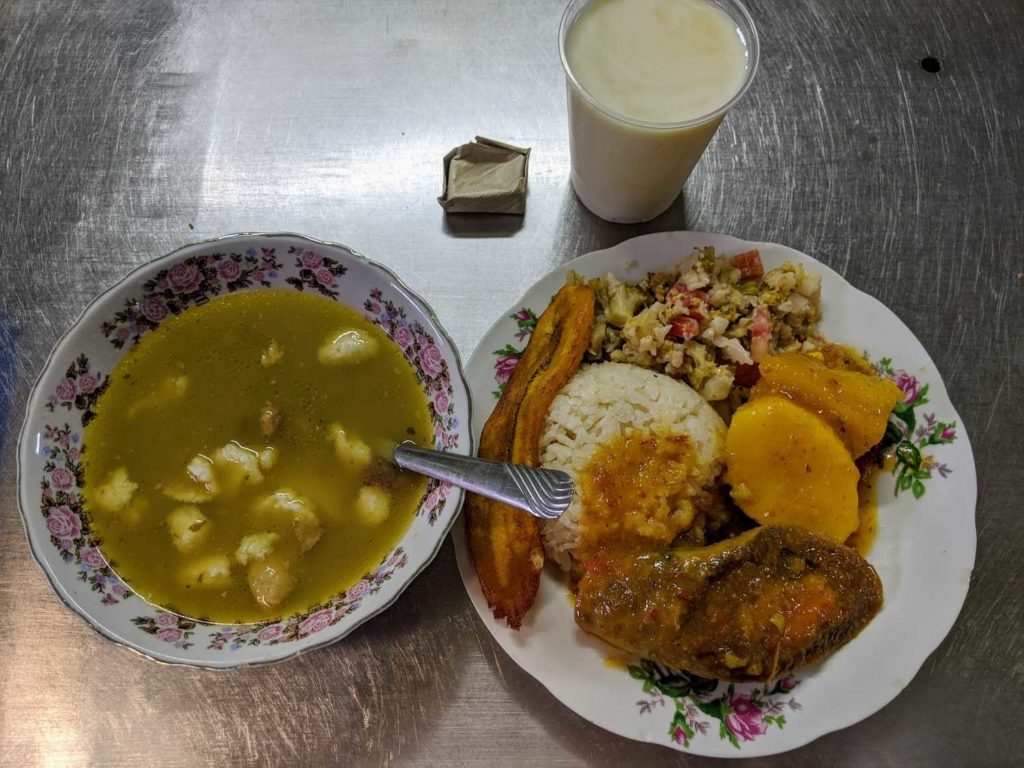
Drinks
Every menú comes with a free drink. You can ask for water, but they’ll still want to give you a drink!
The most common drink is limonada. But, depending on the region, you might get offered one or more options as well. I personally quickly grew to love the taste of claro with a piece of panela to sweeten it.
| Spanish | English |
|---|---|
| Guarapo/Aguapanela | Cane sugar drink. Often made with panela. Sometimes called aguapanela. Sweet and very cooling. Probably a little high on calories. But so tasty! |
| Limonada | Home-made lemonade, basically the same as guarapo but with a lemon twist. Also excellent! |
| Claro | Chilled corn soup blended with milk. Heavy, hearty, and delicious! Have this with a little piece of panela (cane sugar) in your mouth. Claro is supposedly a digestive aid as well. |
| Mazamorra | A thick, chilled corn soup — like claro but heavier. It’s usually white but sometimes yellow. Get this with a little piece of panela (cane sugar) in your mouth. This is common street food, too. |
| Jugo de piña, tomate de árbol, etc. | Juices are very common — and what’s available varies so ask que jugos hay? and see what you can get. |
| Té limón | Iced lemon tea. Can be sweetened or not sweetened. |
Accompaniments/components
Your meal will usually come with various other things to keep it interesting and varied.
| Spanish | English |
|---|---|
| Maduro (tajada) | Refers to a banana (i.e. un banano maduro) — a ripe banana of some kind, usually fried. It’s sweet and an interesting carb. Can be served as tajadas, i.e. slices of fried maduro. |
| Arroz con coco | Rice with coconut. Sweeter and delicious! I wish this were the standard, like in Thailand. The coconut is often toasted. |
| Mazorca | This is a “cob” of corn. You often get a piece in soup, like in an ajiaco. You may know the word maíz, but Colombians use the word mazorca. I think maybe to say it’s still on the cob. |
| Patacón | Usually a large, very fried pancake of varying thickness, made from green banana. A great and tasty carb, quite heavy. |
| Arepa | Flat corn bready thing. When you get an arepa as a standalone meal option (e.g. from an arepería) it often comes filled with delicious things including sausage, eggs, or anything else. But when it’s accompanying a meal, it will come usually just with butter/margarine, and maybe a block of white cheese on it. |
| Ensaladita | Ensalada, or salad. A fairly obvious word. Only mentioning it because the use of the diminutive throws people off! |
That should be plenty to get you ordering Colombian food in Spanish!


